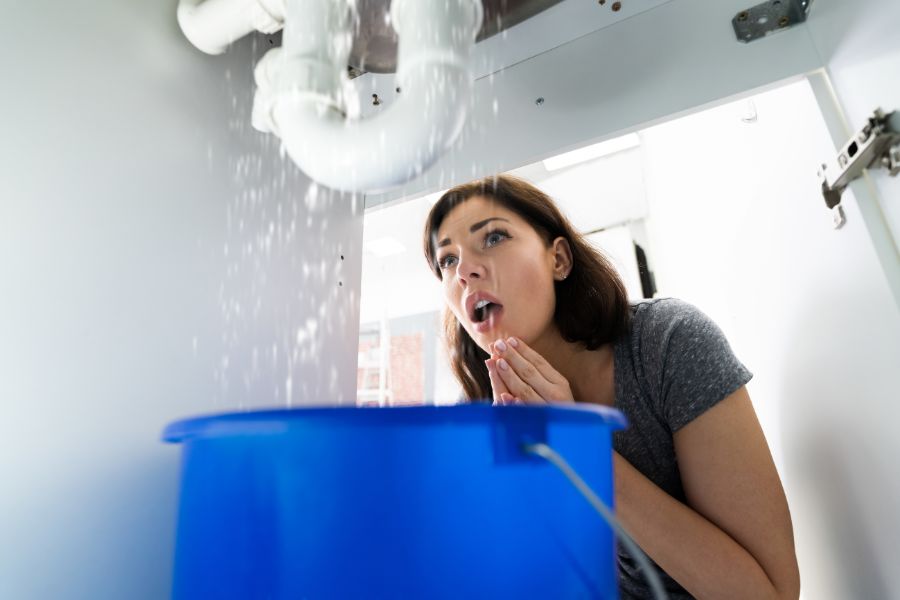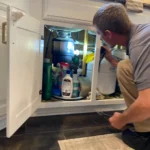Introduction to Pipe Bursts
A burst pipe can transform a peaceful day into a chaotic disaster within minutes, unleashing torrents of water that quickly flood areas meant to remain dry. This deluge can damage walls, floors, and even your home’s structural integrity. Taking immediate action is essential to mitigate the destruction and prevent costly repairs. Pipe bursts can stem from various causes, such as freezing temperatures that make the water inside expand, pressure buildup due to blockages, or the deterioration of aging pipes. Poor installation and subpar materials can also contribute to these emergencies. Understanding what triggers pipe bursts helps you act swiftly and effectively during such crises.
Recognizing the Signs of a Burst Pipe
Visible Damage and Sounds
Sometimes, the signs of a burst pipe aren’t as obvious as water gushing out of the walls. Visible water damage, such as stains on ceilings, walls, or floors, can be the first clue. Listen for unusual sounds like hissing, whistling, or bubbling within the pipes—these noises often accompany water escaping from its intended path.
Water Pressure Changes
Another telltale sign is a sudden drop in water pressure, particularly if it’s isolated to certain areas of your home. If your water bills are inexplicably higher than usual, it might be the result of a hidden burst leaking water continuously.
Initial Steps to Take When a Pipe Bursts
Turning Off the Water Supply
The first thing you must do when a pipe bursts is to stop the flow of water. Locate your main water valve and turn it off immediately to prevent further flooding. Once the water supply is off, drain all faucets and toilets to relieve any remaining pressure in the pipes.
Identifying the Location of the Burst
Identifying the exact location of the burst, if possible, can help expedite repairs once professional help arrives.
Contacting an Emergency Plumber
Why You Need Immediate Help
When facing a burst pipe, contacting an emergency plumber is crucial. A professional can assess and repair the damage efficiently, preventing further complications. When making the call, provide essential details, such as the location of the pipe and any visible damage.
Finding the Right Emergency Plumbing Service
If you don’t already have a trusted plumber on speed dial, look for reputable 24/7 services with positive reviews and proper licensing.
Mitigating Damage While Waiting for the Plumber
Removing Water
While you wait for help to arrive, there are several steps you can take to minimize damage. Start by removing excess water using towels, buckets, or a wet vacuum.
Protecting Your Belongings
If the flooding is substantial, move furniture and other valuable items to dry areas to prevent water damage. Properly ventilating the area by opening windows or using fans can also help slow the onset of mold, which thrives in damp environments.
Temporary Fixes You Can Apply
Pipe Clamps and Epoxy Putty
In some cases, you may be able to temporarily patch the problem while awaiting burst pipe repair. Pipe clamps can provide a quick, albeit short-term, solution to stop water leakage. Another option is to apply epoxy putty to the affected area, which can seal smaller holes and cracks.
Using a Pipe Repair Kit
If you have a pipe repair kit on hand, it may offer a more durable stopgap measure until the emergency plumber arrives.
What Happens During the Professional Repair Process
Diagnosing the Issue
When the plumber arrives, they will begin by diagnosing the issue. They’ll determine whether the pipe requires a simple patch or a complete replacement.
Repairing or Replacing the Pipe
In many cases, burst pipe repair is feasible, but for older or severely damaged pipes, replacement is often the best course. Professionals use high-quality materials to ensure the repair lasts, reducing the risk of future bursts in the same location.
Understanding the Costs Involved
Factors Affecting the Price
The cost of repairing a burst pipe can vary significantly based on factors like the severity of the damage, the location of the burst, and the materials needed. Emergency services typically come with a higher price tag, especially if it’s after hours.
Ways to Mitigate Costs
On average, repairs can range from a few hundred to several thousand dollars. To mitigate these costs, regular maintenance and proactive measures are key.
Preventing Future Pipe Bursts
Insulating Pipes
Preventing future pipe bursts requires consistent care and attention to your plumbing system. Insulating pipes, particularly in cold climates, is one of the most effective ways to prevent freezing and expansion.
Scheduling Regular Inspections
Scheduling regular plumbing inspections can catch potential problems before they escalate. If your pipes are outdated or made from materials prone to corrosion, consider upgrading to more durable alternatives.
Insurance Considerations
Coverage for Water Damage
One question homeowners often ask is whether insurance will cover the damage caused by a burst pipe. In most cases, standard home insurance policies cover sudden and accidental water damage.
When Insurance Won’t Cover Damages
However, damage resulting from long-term neglect or improper maintenance may not be covered. It’s essential to understand your policy and file a claim promptly, documenting all damages and repairs for smoother processing.
Dealing with Water Damage After a Burst
Drying Out the Affected Areas
Water damage can linger long after the pipe is fixed, particularly if not addressed promptly. Mold and mildew can begin to grow within 24-48 hours in a wet environment, leading to health risks and further structural damage. It’s vital to dry out affected areas completely, either by using fans and dehumidifiers or hiring professional water damage restoration services to ensure your home is safe.
Mold Prevention
Properly ventilating and dehumidifying the space helps to avoid mold growth, which can cause both health and structural issues.
Long-Term Impact on Your Home
Structural Damage
The long-term consequences of a burst pipe can extend beyond cosmetic water damage. Structural components like drywall, flooring, and even the foundation can be compromised.
Electrical Hazards
Additionally, electrical systems exposed to water pose serious hazards. Ignoring these problems can result in costly repairs down the line, making it crucial to address all aspects of the damage as soon as possible.
When to Consider Re-Piping Your Home
Signs You Need Re-Piping
If you’ve experienced multiple bursts or your plumbing system is aging, it may be time to consider re-piping your home. Outdated materials, such as galvanized steel or polybutylene, are more prone to leaks and bursts.
Benefits of Re-Piping
Re-piping offers long-term peace of mind by replacing vulnerable pipes with more modern, durable materials like copper or PEX.
The Role of Emergency Plumbers Beyond Pipe Bursts
Additional Emergency Services
Emergency plumbers handle more than just burst pipe repair. They’re trained to tackle various urgent issues, from clogged drains and overflowing toilets to malfunctioning water heaters. Their swift response to emergencies can save homeowners from costly repairs, offering a vital service that protects both property and health.
Swift action is the cornerstone of minimizing the damage caused by a burst pipe. Knowing the steps to take and enlisting the help of an emergency plumber ensures that your home remains safe from further harm. By staying proactive with maintenance and understanding the intricacies of your plumbing system, you can prevent future catastrophes and preserve the integrity of your home.
Frequently Asked Questions on Emergency Plumbing Services
- What should I do first when a pipe bursts?
The first step is to locate and immediately turn off the main water valve to stop the water flow. This action prevents further flooding and minimizes damage. Once the water is shut off, contact an emergency plumber for immediate burst pipe repair to prevent additional harm. - How can I prevent pipes from bursting in cold weather?
To protect pipes from freezing and bursting during cold weather, insulate any exposed pipes, maintain a consistent indoor temperature, and allow faucets to drip slightly during freezing conditions to relieve pressure buildup. Regular plumbing inspections also help detect vulnerabilities early on. - Will my homeowner’s insurance cover burst pipe damage?
Most homeowner’s insurance policies do cover sudden and accidental water damage from a burst pipe. However, damage due to long-term neglect or lack of maintenance might not be covered. It’s important to review your policy and document any damages thoroughly when filing a claim. - How long does it take to fix a burst pipe?
The time it takes to repair a burst pipe depends on the severity and location of the damage. A simple burst pipe repair can be completed in a few hours, but if the damage is more extensive or requires pipe replacement, it could take longer. An emergency plumber will assess the situation and give you a time estimate based on the specific case.
Can I repair a burst pipe temporarily while waiting for a plumber?
Yes, temporary solutions such as pipe clamps or applying epoxy putty can help stop the leak temporarily. However, these fixes are not long-term solutions. It’s crucial to call an emergency plumber to perform a permanent burst pipe repair and prevent further damage.











